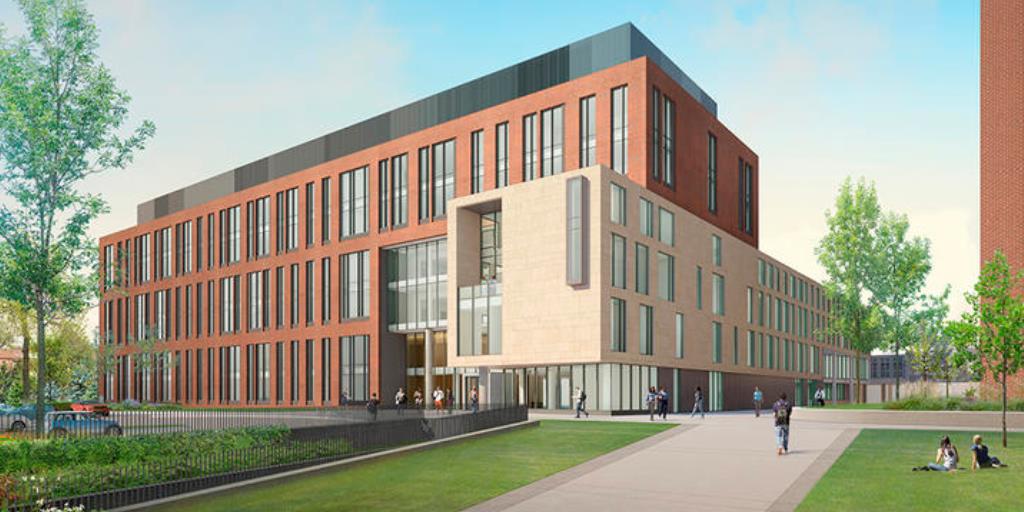

By Jay Johnson, Transwestern
Hospitals and healthcare systems share a common challenge when it comes to including real estate considerations in corporate planning. After all, real estate administrators typically come from careers in property management, leasing or facilities operations, without direct experience in the delivery of patient care.
Likewise, the top leaders in a given hospital system usually ascended the ranks on the healthcare side, with little exposure to real estate contracts, maintenance or property management. Both groups are strongly dedicated to the healthcare mission, but are not always able to create the proper alignment between business strategy and real estate.
This common state of affairs puts the healthcare organization at a disadvantage, however. Real estate has the potential to increase patient access, generate cash flow, increase efficiency and drive growth. A key to unlocking that potential is managing real estate as a portfolio rather than a series of individual properties.
With the right processes and technology, the real estate team can provide valuable insight on a per-property and per-square-foot basis. For example, tracking may reveal that a fully occupied clinic has half as many physicians per square foot as other assets in the portfolio. This hidden vacancy is an opportunity to add doctors—and business—without the expense of acquiring new space, or disposing of costly excess space.
When an organization decides to buy, lease or construct new space, the real estate team may be called in after business planning is far along. However, by including real estate experts in strategy meetings before a site search begins, healthcare executives can make a more informed site selection, especially in regard to patient access, and more accurately project its construction and operating costs, which are significant components of the overall business case for the expansion. Property managers also can help determine whether existing building teams can handle the new location, or if additional managers, engineers and housekeeping staff will be required.
More broadly, the real estate team can address the property component of planning hospital mergers or acquisitions of physician practices. Too often, the team inherits these properties with no idea why a site was acquired, its long-term role, or how to service it with existing resources.
Engineers can predict whether existing utilities, HVAC and parking will adequately serve a new building on campus, or be prone to failure by the added strain. And if the organization is correlating its real estate to its tracking of physicians, patients and other indicators of hospital operations, it will have a clearer understanding of whether it really needs a new building, or if there is already capacity in the portfolio to serve its needs.
When a healthcare system integrates real estate in measuring overall operational performance, the need for including portfolio management in business planning quickly becomes apparent. And the data and analyses generated through this inclusive approach will provide a common ground that speaks to both real estate managers and hospital executives, bridging the gap that all too often divides them.
Source: GlobeSt.

Along Virginia Avenue, toward main campus, you’ll find the steel skeleton of a new research building under construction. This is Research Building 2 (RB2), a precious resource and a vehicle for the University of Kentucky to reduce the health disparities that most impact Kentucky.
This building will house researchers that focus on the following disparities: cancer, obesity, diabetes, cardiovascular diseases including stroke, and substance abuse. These conditions have a major adverse impact on the health of Kentuckians, contributing to death rates from each disease that rank within the top 11 states in the nation.
RB2 will enable multidisciplinary research that approaches these disparities from numerous fields and perspectives—health care researchers (both basic and clinical), public health, behavioral sciences, agriculture outreach and extension, economics and engineering—working in close proximity and collaboratively to develop solutions to these complex problems.
This $265 million building (funded half from the state of Kentucky, half from university resources, including private gifts) is scheduled to open in summer of 2018.
The design of this modern research facility embodies a lifestyle that reduces health disparities, including a healthy food choice restaurant, a room to house bicycles for travel to and from the facility, and prominent staircases to encourage physical activity.
Within the laboratories, the design and focus comes with a specific scientific underpinning: much of discovery today, whether at the cellular or community level, happens at the intersection of disciplines. This facility, by placing investigators together in “neighborhoods,” is designed to foster discovery and collaboration so that what happens in the course of basic research can be translated to answers and solutions at the community level.
By placing people, who are working on the same problem—say, cancer—but from different angles (economics, biomedicine, public health), next to each other in a single building facilitates communication and promotes new avenues for problem solving. Through this design, the project will improve the lives of Kentuckians by providing modern space that lends itself to multidisciplinary research that is needed to address entrenched health problems.
While each of these major diseases influence citizens across the Commonwealth, they are of immense concern to our citizens residing in rural Appalachia, a region with some of the most pronounced rates of chronic diseases in the country. A recent report from the University of Washington showed rates of death from cancer in the United States dropped by 20 percent between 1980 and 2014. However, these gains were not distributed equally across the country. Clusters of high mortality were found in many states, including Kentucky. Four main factors are thought to drive these disparities: socioeconomic status, access to health care, quality of health care available, and prevalence of risk factors, such as smoking, obesity and lack of physical activity. The Appalachian region of Kentucky experiences a perfect storm of these factors driving disparities. A primary focus of research within the new building will be determining factors that drive more disease risk and burden in Appalachia, and developing preventive and therapeutic approaches that are optimized to have greater benefit to those living in this region.
RB2, the Biological Biomedical Research Building (BBSRB) and the Lee T. Todd Jr. Building will be linked in complex, to further foster collaborative and multidisciplinary research. The connecting conduit building, serving as the spine of the complex, has been named the Appalachian Translational Trail, as it will house the nucleus of translational researchers who bring together all disciplines.
The real power of research is realized in bringing different groups of experts together, and in order to tap into that power, we applied a multidisciplinary approach to the planning of this new building. We began by aligning our work with the goals of the 2015-2020 Strategic Plan. These are invest in UK’s existing strengths and areas of growth in selected focus areas that benefit and enrich the lives of the citizens of the Commonwealth; recruit and retain outstanding faculty, staff and students; improve the quality of the research infrastructure across campus; and strengthen engagement efforts and translation of research. The planning and implementation of RB2 touches on each of these goals.
The health disparities we are targeting are, indeed, areas of current UK strength in research and health care. We have strong individual investigators across all colleges at UK, as well as existing collaborative research centers that can bring intensified focus in these areas. We’ve tapped these experts, based on thematic areas in each of these health disparities, to use data (i.e. grant funding, expenditures, research space) to evaluate our current resources, and identify areas in which we could strategically invest to expand resources and hire new investigators, who will most likely be housed within RB2, to make the biggest impact for Kentucky.
By growing our research enterprise to focus on the most critical health needs of Kentucky, we can translate basic science findings to clinical practice and to the community to fight these devastating health disparities and improve the quality of life for Kentuckians. We thank Kentucky legislators for their support of RB2, and we will do everything in our power through this precious resource to make that difference.
Source: UK Now

Immediate-care clinics offer more than just speedy stitches and X-rays. For several Chicago-area health systems, they also provide a quick path to growth, so regional hospitals are doubling down on them—and spooking private players that have dominated the local market to date.
“The healthcare systems have been a little slow to grow in the city,” says Sarah Cogswell, a senior vice president in the healthcare practice of real estate firm JLL. “But as millennials continue to drive population growth, the systems are responding.”
Historically, hospitals have tried to increase referrals to their affiliated specialists—and therefore their own bottom lines—by opening primary-care practices. Now, though, more hospitals are looking to drum up business through urgent care, which introduces relatively healthy people to their networks at a fraction of the cost of hiring family docs.
Visits to urgent-care centers increased 19% from 2010 to 2015, according to a study by Accenture. Right now, Chicago proper offers 37 immediate-care clinics, more than double eight years ago, according to JLL, which increasingly represents healthcare systems as they expand and gobble up new space. All but nine are private; the private clinics are run by such players as MedSpring Immediate Care of Austin, Texas, and Concentra Urgent Care, headquartered in Addison, Texas.
Private companies dominate the national market, too, owning about three-fourths of the more than 7,000 quickie clinics across the country. In Illinois, there are 196 immediate-care centers in all, about two-thirds of which are private, according to the Urgent Care Association of America, a Naperville-based industry group. Though the niche has already experienced a decade of explosive growth and investment, health system leaders say they’re still bullish.
“We do think there’s going to be continued growth in the immediate-care format,” says Scott Powder, Advocate Health Care’s chief strategy officer. The Downers Grove-based health system operates 22 stand-alone immediate-care centers in metro Chicago, plus 56 retail clinics inside Walgreens stores.
The clinic business model is straightforward and attractive: Treat as many patients with minor injuries and illnesses as quickly as possible—usually in 30 minutes or less. Patients avoid the chaos and eye-popping bills associated with the ER, while hospital systems skip paying for high-tech equipment, large buildings and lots of physicians. As far as cost savings go, many clinics weigh in at a slim 1,500 square feet, come equipped with X-ray machines but not CTs or MRIs, and staff physicians’ assistants or nurse practitioners.
The rising wave of consumerism in healthcare has pushed the immediate-care market to $15 billion nationally this year, a 27% spike since 2011, according to Kalorama Information, a publisher of healthcare data in Rockville, Md. The number of urgent-care centers across the country has increased 14% to 9,300 centers since 2008, according to the American Academy of Urgent Care Medicine in Orlando, Fla.
A typical immediate-care center sees 294 patients each week, a number Kalorama predicts will grow for the next four years. Per-site revenue is expected to increase to nearly $1.7 million by 2021.
Hospital system executives are well aware of those attractive stats—and are racing to grab desirable locations near what industry consultant Thomas Charland calls “the slam-dunk”: dual-income parents with children who can’t disrupt their entire day to finagle a pediatrician appointment for a sick kid.
Hospitals Elbow Their Way In
As hospital systems move toward a world in which they’re paid for the quality of a patient’s care rather than simply a fee-for-service, volume-based approach, they have increasingly implemented narrow networks. The premise is that such networks improve patient outcomes by establishing small pools of providers who score well on efficiency and quality measures.
That’s a problem for the private immediate-care centers, because patients will be increasingly encouraged to visit a hospital-owned, in-network clinic for, say, stitches or a strep test.
“With the emergence of hospital urgent care, a lot of the private operators will be on the outside looking in,” Charland says.
In Chicago, at least one private player is trying to avoid that fate by partnering with a health system. Physicians Immediate Care, based in Rosemont, linked up in 2015 with Presence Health, the state’s largest Catholic health system, to jointly operate 10 clinics in the Chicago area; it now runs 12. Dana Gilbert, Presence’s chief strategy officer, says via email that the joint venture creates more access points and lower-cost settings.
Despite the booming market here, the Chicago area isn’t yet approaching saturation, experts say.
Charland, who runs research consultancy Merchant Medicine out of St. Paul, Minn., tracks the number of clinics in an area and then divides it by 100,000 residents. Any city that scores above a 4.5—such as Louisville, Ky.—is deemed highly saturated. Chicago comes in at a healthy 2.6, assuming a total of 250 stand-alone urgent-care clinics plus retail centers like the ones Advocate runs inside Walgreens.
“I think the private immediate-care centers are probably closer to saturation than the health systems, but I don’t see the overall market as saturated,” says Cogswell. She says that while the private centers have historically acted like retailers, slipping into strip mall spaces or areas close to the CTA with lots of foot traffic, hospitals have cared more about suburban-style amenities.
In 2013, Northwestern Medicine opened five immediate-care centers, in Glenview, Deerfield, Evanston, Lakeview and River North. Last June, a sixth followed in Vernon Hills.
Edward-Elmhurst Health and DuPage Medical Group, meanwhile, are duking it out for immediate-care supremacy in the western suburbs. Edward-Elmhurst opened its seventh center, in Oak Park, in February. Downers Grove-based DuPage Medical, the largest independent doctors group in the Chicago area, will open its sixth quick clinic, in Bloomingdale, in June. The group also just received the thumbs-up from the Naperville City Council to build a 21,000-square-foot addition there. It will house the group’s seventh suburban immediate-care outpost.
Source: Modern Healthcare

Retailers have long learned how to function and adapt to meet their customers’ needs. Competition is fierce and there’s no room for error when it comes to achieving success. Consumers are more informed, connected and empowered than ever before. Thus, retailers have perfected key traits such as branding, standards, speed-to- market, advertising, convenience and site selection. Healthcare systems have much to learn from retail. While they have been laser-focused on delivering exceptional patient care on their primary campuses, they face an onslaught of new challenges as they embrace a retail strategy to expand outpatient services and their ambulatory network.
As healthcare systems add retail locations to improve access, retailers view them as competitors only from a real estate perspective. Traditionally, retailers considered healthcare systems symbiotic partners that could potentially direct new customers to their store. However, in today’s market, retailers are beginning to compete directly with healthcare providers as they add health services to improve access and reach a broader base. Walmart, Target, CVS and Walgreens are just a few that are adding services such as urgent care, lab specimen collection, and even imaging at both new and existing locations. Retail fitness centers are also providing preventive and wellness care to maximize their membership base.
These major retail stores and chains are often found in prime well-established locations with built-in traffic flow and volumes required to succeed. Healthcare systems are now competing with retailers to secure premium locations (i.e., the new corner of Main & Main) where before they only focused on their primary campus and immediate service areas. Competition is coming from all sides and in many ways.
COST OF ENTRY
Ambulatory locations, and more specifically primary care locations, are typically a loss-leader for healthcare systems and have been a vehicle to open new market doors and drive downstream specialty revenue and inpatient referrals. As such, business plans are extremely tight as healthcare systems look to minimize losses across ambulatory networks. Outpatient centers have traditionally been developed within medical office buildings (MOBs) or spaces dominated by other healthcare services. MOBs typically have an abundant supply of available space within any given real estate market. This fosters favorable real estate economics and lowers operational costs for the development of new healthcare space.
However, MOBs do not offer the best patient convenience and overall experience when compared to other retail options. Therefore, recent trends have seen healthcare systems focusing on ground floor space, shopping centers, strip malls and even pad sites for single-use facilities to provide an easily accessible and convenient retail experience. Unfortunately, these alternatives often come with a major price tag. An internal CBRE study across three major metropolitan markets shows prime retail space lease rates coming in, on average, 20% to 30% higher than comparable space within an MOB.
The required capital to develop this new space is also higher. Tenant improvement allowances are typically 15% to 20% lower and less core infrastructure is provided when compared to an MOB. These factors have a negative impact on new ambulatory business plans and increase the overall cost of entry as well as long-term operational costs.
PRICE SHOPPING
Price point matters for consumers in the retail world and it continues to evolve in healthcare as well. The emergence of price shopping and transparency for insurance by consumers, whether through public or private exchanges or traditional products, is having an impact on how consumers are paying for and using healthcare. The most recent signals from the federal government indicate that shopping for insurance is on the rise. Also, dual working households are evaluating cost when deciding which spouse will carry the insurance for the family.
his is not necessarily a new trend, but with the increase in high-deductible plans, families have a choice and are scrutinizing insurance packages more closely. This is driving consumers’ willingness to pay out of pocket and shop for insurance products that will balance out-of- pocket expenses with premiums. Price competition is making healthcare providers focus on efficiencies within their cost model or offer additional services that make up any revenue differences.
DATA-DRIVEN ANALYTICS MUST DRIVE STRATEGY
Retailers rely on robust analytic platforms to understand consumer behaviors, trends, patterns and opportunities. More data has been created in the past two years than in the entire previous history of the human race. According to SINTEF, 90% of the data in the world today was created over a two-year period and continues to evolve. Understanding how to use and apply this information is an even bigger challenge. Partnering with a healthcare data firm to mine consumer traits such as origin, demographics, payer mix and utilization rates is a key first step to any successful retail strategy.
However, the data alone is not the answer. The true value comes in its application. Healthcare systems must be able to incorporate analytic research into both their overall healthcare strategy AND their real estate strategy (short term and long term). This is where healthcare systems have a significant leg up on their new retail competitors. Retailers cannot rely on downstream revenue sources to support new healthcare endeavors, and they’re slowly learning how complex and challenging healthcare delivery can be.
DECISION MAKING & STANDARDS
Standards and prototypes must be developed and implemented to ensure speed to market. Successful healthcare retailers cannot afford to second guess their strategic plan once it has been implemented. Don’t get caught in the trap of customizing each location to appease provider preferences. Competition will quickly take advantage of any lost momentum and capture whatever remaining market share still exists. The best locations will disappear, consumers and patients will find alternate sources for care, and development opportunities will quickly be lost. Discipline is required. There’s a reason that retail outlets are designed and branded in a specific way.
CREATIVE ADVERTISING & SOCIAL MEDIA
To compete in the retail space, healthcare systems must expand their traditional advertising channels to include social media. Increasing brand awareness and acceptance is more than just a Facebook page. Out-of- the-box thinking must be applied. More and more patients are relying on advice gleaned from the internet for everything, including their health. According to Software Advice, 77% of patients surveyed used online reviews as their first step in finding a new doctor. New healthcare apps and wearable devices are hitting the market every day. Wellness has become trendy as devices have become mainstream and social media has impacted how people track and promote a healthy lifestyle. Systems must ensure their retail strategies encompass solutions geared toward wellness as well as episodic care when ill or injured.
BRANDING & CUSTOMER SATISFACTION
Even though price point matters, retailers have learned that consumers are very loyal if they’re provided with exceptional services and superior outcomes. Studies have shown that 86% of consumers are willing to pay more for a better experience. And given that consumers are likely to have 65 times more retail encounters than healthcare encounters over the course of a calendar year and eight times more outpatient encounters than inpatient encounters, it’s imperative for healthcare systems to invest heavily in customer experience and ensure consistency at all ambulatory and retail locations. Each positive customer experience will firmly reinforce the new retail brand and magnify downstream revenue opportunities.
VIRTUAL COMPETITION
And don’t forget about virtual healthcare. It should also have a place in a system’s strategic plan. Telehealth applications are beginning to impact consumer utilization and spending habits, similar to the effect of online shopping over the past decade. By 2018, it’s estimated the number of patients using telehealth services will rise to 7 million. While virtual visits may not be covered by insurance, many consumers are opting for this route, regardless of the cost, due to convenience or access to care. An increasing
number of patients are also finding that telehealth visits aid in managing chronic conditions and assist in reducing readmission rates.
CONCLUSION
As healthcare continues to move away from the central hospital and systems expand their footprint, organization leaders must embrace new technologies and approaches to care delivery. Unheard of in the past, patients are becoming savvy consumers that evaluate service, outcomes and price prior to selecting a provider. And, all the while, competition continues to grow. To remain viable, strategies must be creative, consistent and deliberate. Look to other industries and identify best practices that can be replicated in healthcare. Retail was just the first step. We can only imagine what lies ahead.
Source: BDC
